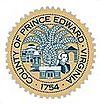Prince Edward County, Virginia facts for kids
Quick facts for kids
Prince Edward County
|
|||
|---|---|---|---|
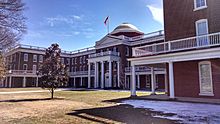
The Rotunda at Longwood University in Farmville.
|
|||
|
|||
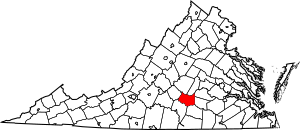
Location within the U.S. state of Virginia
|
|||
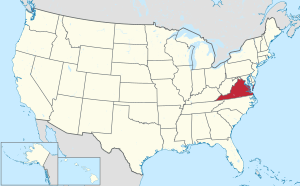 Virginia's location within the U.S. |
|||
| Country | |||
| State | |||
| Founded | 1754 | ||
| Named for | Prince Edward, Duke of York and Albany | ||
| Seat | Farmville | ||
| Largest town | Farmville | ||
| Area | |||
| • Total | 354 sq mi (920 km2) | ||
| • Land | 350 sq mi (900 km2) | ||
| • Water | 3.9 sq mi (10 km2) 1.1% | ||
| Population
(2020)
|
|||
| • Total | 21,849 | ||
| • Density | 61.72/sq mi (23.83/km2) | ||
| Time zone | UTC−5 (Eastern) | ||
| • Summer (DST) | UTC−4 (EDT) | ||
| Congressional district | 5th | ||
Prince Edward County is a place in the state of Virginia, USA. In 2020, about 21,849 people lived there. The main town, where the county government is, is called Farmville.
Contents
History of Prince Edward County
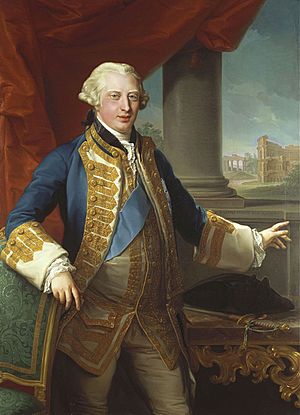
How the County Was Formed
Prince Edward County was created in 1754. It was part of the Virginia Colony at that time. The land for the county came from Amelia County.
The county was named after Prince Edward, Duke of York and Albany. He was the second son of Frederick, Prince of Wales. He was also the younger brother of George III of the United Kingdom, who was a king.
Early County Seats
The first county seat was called Prince Edward Courthouse. This place is now known as the village of Worsham. It was where the main courthouse was located.
Later, the town of Farmville was started in 1798. It became an official town in 1912. In 1871, the county seat moved from Worsham to Farmville.
Railroads and the Civil War
In the 1850s, a railroad called the Southside Railroad was built. It connected Petersburg and Lynchburg. This railroad passed through Farmville.
Building the railroad through Farmville was expensive. It needed a large bridge over the Appomattox River. This bridge became famous as the High Bridge.
The Southside Railroad was badly damaged during the American Civil War. The High Bridge was very important during the final retreat of Confederate General Robert E. Lee. His army was moving from Petersburg to Appomattox Courthouse. This is where Lee surrendered to Union General Ulysses S. Grant in April 1865.
After the war, the Southside Railroad was rebuilt. It later became part of the Norfolk and Western railway. Today, it is part of the Norfolk Southern Railway system.
Desegregation and Civil Rights
Prince Edward County played a big role in the fight for civil rights. A court case from here, Davis v. County School Board of Prince Edward County, became part of the famous Brown v. Board of Education case. This case led to the U.S. Supreme Court deciding that separate public schools for different races were against the law. This decision helped end segregation in all public schools across the United States.
The case started because students at the all-black R.R. Moton High School protested. They walked out of school in 1951. They were upset about their crowded school and poor conditions. Their school did not have a gym, cafeteria, or even teachers' restrooms. Some classes were held in plywood buildings or even on a school bus.
A 16-year-old student named Barbara Rose Johns led this protest. The NAACP (National Association for the Advancement of Colored People) helped the students. Lawyers filed a lawsuit against the county school system.
Even though a state court first rejected the lawsuit, it was later appealed. It became one of five cases included in Brown v. Board of Education. In 1954, the Supreme Court made its landmark ruling.
Massive Resistance in Prince Edward County
After the Brown decision, some states, including Virginia, tried to avoid integrating schools. This was called "Massive Resistance." In 1956, Virginia passed laws to allow money to be given to students to attend private schools. In reality, this helped create private schools just for white children. These were called "segregation academies."
In 1959, the leaders of Prince Edward County made a drastic decision. They refused to give any money to the public schools. This meant all public schools in the county closed down. They stayed closed for five years rather than allow white and black students to attend school together. Prince Edward County was the only school district in the entire country to do this.
During these five years, white parents started private schools for white children. These schools received money from the state and tax breaks from the county. They were known as "Prince Edward Academy."
Black students in Prince Edward County had a very hard time. Many had to go to school in other places or simply missed out on their education. Some lived with relatives in other towns. Others attended makeshift schools in church basements. Some even went to schools outside the state with help from groups like the Quakers. In the last year of the closure (1963-1964), the Prince Edward Free School helped educate some black students.
In 1963, federal courts ordered the public schools to reopen. Prince Edward County appealed this decision. But in May 1964, the U.S. Supreme Court ruled that the county's actions were illegal. The county then had to reopen its public schools. This ended the "Massive Resistance" era in Virginia.
Because of these actions, some students missed five years of school. They are sometimes called the "Lost Generation" of Prince Edward County.
Private Education After 1964
Even after public schools reopened, Prince Edward Academy remained segregated for a while. Many of these private schools eventually changed their rules or closed. Prince Edward Academy lost its tax-free status in 1978 because it was still segregated.
In 1986, the school started accepting all students, no matter their race. In 1992, it was renamed the Fuqua School. This was to honor J. B. Fuqua, a businessman who supported the school. Fuqua School is still the main private school in Prince Edward County today.
Robert Russa Moton Museum
The old R.R. Moton High School building in Farmville is now a very important place. In 1998, it was named a National Historic Landmark. It is now the Robert Russa Moton Museum. This museum is a center for learning about civil rights in education.
Geography and Location
Prince Edward County covers about 354 square miles. Most of this area is land, with a small part being water. Most of the county's streams flow into the Appomattox River. This river then flows into the James River. In the southeastern part of the county, streams flow into the Nottoway River. The highest point in the county is Leighs Mountain, which is 714 feet above sea level.
Neighboring Counties
Prince Edward County shares borders with these other counties:
- Cumberland County – to the north
- Buckingham County – to the northwest
- Amelia County – to the northeast
- Appomattox County – to the west
- Nottoway County – to the east
- Charlotte County – to the southwest
- Lunenburg County – to the southeast
Main Roads in the County
Several important roads pass through Prince Edward County:
 US 15 (Farmville Rd)
US 15 (Farmville Rd) US 360 (Patrick Henry Hwy)
US 360 (Patrick Henry Hwy) US 460 (Prince Edward Hwy)
US 460 (Prince Edward Hwy) SR 45 (N. Main St in Farmville)
SR 45 (N. Main St in Farmville) SR 307 (Holly Farms Rd)
SR 307 (Holly Farms Rd)
Population and People
| Historical population | |||
|---|---|---|---|
| Census | Pop. | %± | |
| 1790 | 8,100 | — | |
| 1800 | 10,962 | 35.3% | |
| 1810 | 12,409 | 13.2% | |
| 1820 | 12,577 | 1.4% | |
| 1830 | 14,107 | 12.2% | |
| 1840 | 14,069 | −0.3% | |
| 1850 | 11,857 | −15.7% | |
| 1860 | 11,844 | −0.1% | |
| 1870 | 12,004 | 1.4% | |
| 1880 | 14,668 | 22.2% | |
| 1890 | 14,694 | 0.2% | |
| 1900 | 15,045 | 2.4% | |
| 1910 | 14,266 | −5.2% | |
| 1920 | 14,767 | 3.5% | |
| 1930 | 14,520 | −1.7% | |
| 1940 | 14,922 | 2.8% | |
| 1950 | 15,398 | 3.2% | |
| 1960 | 14,121 | −8.3% | |
| 1970 | 14,379 | 1.8% | |
| 1980 | 16,456 | 14.4% | |
| 1990 | 17,320 | 5.3% | |
| 2000 | 19,720 | 13.9% | |
| 2010 | 23,368 | 18.5% | |
| 2020 | 21,849 | −6.5% | |
| U.S. Decennial Census 1790–1960 1900–1990 1990–2000 2010 2020 |
|||
Population in 2020
| Race / Ethnicity | Pop 2010 | Pop 2020 | % 2010 | % 2020 |
|---|---|---|---|---|
| White alone (NH) | 14,544 | 10,513 | 62.24% | 48.12% |
| Black or African American alone (NH) | 7,668 | 9,194 | 32.81% | 42.08% |
| Native American or Alaska Native alone (NH) | 60 | 33 | 0.26% | 0.15% |
| Asian alone (NH) | 203 | 196 | 0.87% | 0.90% |
| Pacific Islander alone (NH) | 15 | 0 | 0.06% | 0.00% |
| Some Other Race alone (NH) | 33 | 61 | 0.14% | 0.28% |
| Mixed Race/Multi-Racial (NH) | 320 | 764 | 1.37% | 3.50% |
| Hispanic or Latino (any race) | 525 | 1,088 | 2.25% | 4.98% |
| Total | 23,368 | 21,849 | 100.00% | 100.00% |
Education in Prince Edward County
The public schools in Prince Edward County are all located on one campus in Farmville. These schools are:
- Prince Edward County Elementary School
- Prince Edward County Middle School
- Prince Edward County High School
There is also a Career & Technical Education Center on the campus. It offers special classes like carpentry and automotive technology.
The Fuqua School is a private school in Farmville. It is an option for students from kindergarten through 12th grade.
Two colleges are also in Prince Edward County:
- Hampden-Sydney College is a private college for men. It is located south of Farmville.
- Longwood University is a public university in Farmville. It is one of the oldest public universities in Virginia.
Towns and Communities
Towns
- Farmville (part of this town is also in Cumberland County)
- Pamplin City (most of this town is in Appomattox County)
Census-Designated Place
Other Communities
These are smaller communities in the county:
- Green Bay
- Meherrin
- Prospect
- Rice
- Tuggle
- Israel Hill (This used to be a community for free black people and is now part of Farmville.)
Notable People from Prince Edward County
Many interesting people have come from Prince Edward County:
- J. B. Fuqua: A businessman and generous person. The Fuqua School is named after him.
- Joseph Eggleston Johnston: A general in the Confederate Army.
- Henry Watkins Allen: A Confederate Army officer, born in the county.
- Blanche Kelso Bruce: The first black person to serve a full term as a U.S. Senator (1875-1881). He was born a slave in Prince Edward County.
- Charles S. Venable: A Confederate Army officer and lawyer who worked with General Robert E. Lee.
- Abraham Bedford Venable: A U.S. Representative and Senator from the county in the early 1800s.
- Reverend Vernon Johns: A well-known leader in the civil rights movement.
- James West: An inventor with over 250 patents.
- Lieutenant General Samuel V. Wilson: Known as "General Sam," he was a director of the Defense Intelligence Agency and helped create Delta Force.
See also
 In Spanish: Condado de Prince Edward para niños
In Spanish: Condado de Prince Edward para niños



